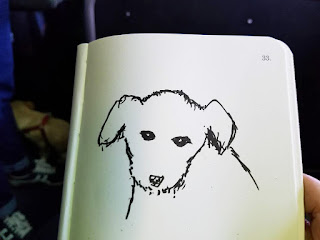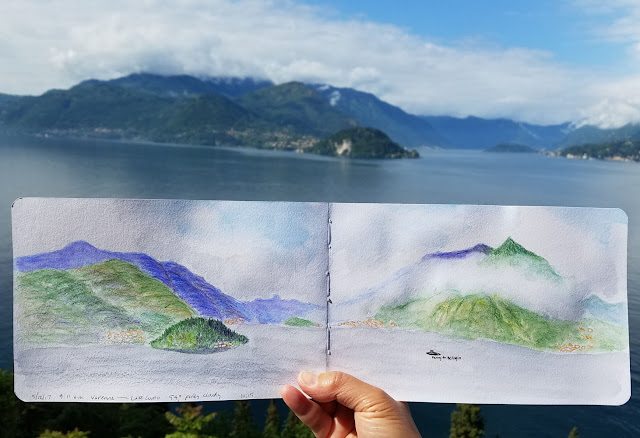 |
| 11/22/17 Roosevelt neighborhood |
In Mike Daikubara’s book on urban sketching, he talks quite a bit about how to manage one’s time
and expectations to get great sketches, no matter the circumstances. He uses a quadrant
graph to explain how he manages his own sketching based on his energy level and
the time available. For example, if he’s tired and low on energy, he would need
more time to sketch, and conversely, if has plenty of energy, he might attempt a
sketch in a very short time. If he’s low on both, he might not attempt it at
all. He also has ideas for scaling back on color or details if he’s running out
of time but wants to leave a sketch at a place of completion rather than simply
stopping and leaving it unfinished. He has developed a solid set of strategies
that he has honed over the many years that he has been sketching.
As I was reading, I realized that although I have
slightly different tactics, I, too, have come to develop my own strategies for
managing my time and expectations for sketching. Like Mike, I’ve been honing
these strategies for a while. Unlike Mike, however, I don’t know how to teach them
(or whether they can be learned) – I think they come from experience.
When I first started out, I used to think I needed a
relatively large chunk of time to “do urban sketching,” and I did. That large
chunk of time began even before I left the house, choosing and prepping my materials:
Should I bring watercolors today? Then I’d better bring the watercolor paper sketchbook.
But it’s so heavy – maybe not. Oops, I’d better not forget brushes and a water
cup. Oh, maybe I’ll skip it and just bring markers. If so, which colors? If I
go to the park, I’d better have lots of greens. If I go downtown, I won’t need
many greens. Hmm, I do want to try this larger sketchbook today – I need a different
bag now. Should I bring a stool? On and on.
Once I finally arrived at my destination, I’d spend quite
a bit of time looking for subject matter that appealed to me or looking for the
“right” angle (without really understanding what the right angle might be). I
would draw a woman sitting on a park bench by starting with her face, her hair,
her jewelry, the pattern on her jacket, and suddenly, she would leave. Then I’d
have to start over with a new sketch. Three hours later, I’d go home with one
or two complete sketches, and indeed, “doing urban sketching” took a
substantial chunk of time.
After about a year, I got tired of the whole kit-prep process
of deciding which materials to bring each time I sketched. I made a significant shift – both practically and mentally – by carrying all my materials with me all the time, every day, whether I planned to use them or not. To do that, I had to
pare down my options and think about what I really needed (obviously still an ongoing process!). But more important, my choice
to do so changed urban sketching from a hobby
(defined by me as something I do during a substantial chunk of planned spare
time) to a lifestyle (something that
doesn’t require much thought or prep because it’s integrated into my ordinary
day).
That shift changed not only my sketch kit; it also changed
my attitude and ultimately the amount of time I “needed” to make a sketch. I
still have many occasions when I consciously set aside a chunk of time to
sketch subject matter that particularly appeals to me or that I want to observe
closely, and every time I go out with Urban Sketchers is such an occasion. But
day to day, sketches fit into whatever slot of time is available. And that
means I sketch regularly, which is important to me in maintaining a practice and a habit.
Yesterday after running an errand, I returned to my car
and realized that I still had 29 minutes left on my meter. I had paid for that
time; I intended to use it – and I spent exactly 29 minutes on the sketch at the
top of the page. How did I know it would take me exactly 29 minutes? I used one
page of my standard 6-by-9-inch DIY sketchbook, and almost amazingly invariably,
it takes me about a half-hour to make a sketch of that size (with color, a
little longer – maybe 35 or 40 minutes). As you can see, I also didn’t spend
any time looking for appealing subject matter or the right angle – I just drew
what I saw through the wet windshield.
 |
| 11/17/17 Furry commuter |
A few days ago on the bus, I spotted a puppy in the aisle
nervously twitching and circling his standing human’s feet. That small sketch
took a few seconds because I knew that’s all he would give me. (Actually, it probably
took a minute longer than that if you count the time I waited for him to face
me.)
The hooded man on a different bus took five minutes. I
know this because at the point that I started sketching him, it takes five minutes
to reach the transit station. (There was a small risk that he would get off at
an earlier stop, but I could tell by the way he was sitting that he probably
wouldn’t.) I finished most of the sketch in probably four minutes, then used the
remaining time to add a little more detail, like the stitching around his hood
and a few more hairs on his beard.
 |
| 11/17/17 Hooded commuter |
On rare occasions I have what would be considered optimal
circumstances by most sketchers’ standards. One was in Varenna, Italy, last May. Greg was fully occupied with photography,
so I didn’t have to worry about him. It was a beautiful morning – warm but not
hot, a partly cloudy sky, not windy. Lake Como and the mountains around it were
exactly the hues of the secondary triad palette I had just learned about in my colored pencil class and was eager
to try on location.
In class, working from a photo, I would have probably
taken many hours to complete a drawing, and I knew I didn’t want to spend that
long, but I wasn’t sure how much time it might take. The landscape-format panorama
spread I used is just a little smaller than two 9-by-6-inch pages in my regular
DIY sketchbook, and remarkably, my Lake Como sketch took just about an hour. Even
under optimal conditions, I still seem to sketch at about the same rate. Maybe that’s
just the limit of my sketching patience. (I really didn’t set out to develop
such a reliable time frame, but it’s convenient.) In any case, I had to focus
my attention on the aspect (color) that was important to me about this
composition so that I would have time for it. (And drafting took very little
time, because I decided these mountains didn’t require much accuracy.)
 |
| 5/17/17 Lake Como |
I wish I had a formula for developing a strategy like
this, but as I mentioned earlier, I think it just requires some experience. When
beginning sketchers tell me they need “more time” to sketch, I jokingly respond
with, “Just lower your standards.” It sounds snarky, but I’m being
realistic to my own experience. If you spend less time looking for “inspiring”
subject matter, you learn to find something interesting about whatever is in
front of you. If you’d like to sketch the whole puppy, lower your standards and
sketch only his face, which is all he’ll sit still for. If color is important
to you, don’t worry about getting the shape of the mountains right. If you have
limited time (which is almost always), spend some of it deciding what’s
important to you about what you see, and focus on that – not on everything.
It’s not important
to find out whether a 6-by-9-inch sketch takes you a half-hour; your process might
or might not lead to a reliable time frame. What is important, though, is sketching regularly, because that’s what gives you the experience that helps
you gauge how much of a sketch you can do before your meter runs out (or whether
you care).
Your post the other day about a minimal sketch kit made me think and I did a post about that today. Sketch time is another thing that deserves some thought...but not too much or you won't get a sketch done. I can easily sit and do a sketch that takes an hour, or maybe a little more, but I have learned that when I don't have a lot of time I can change the materials I use and get a sketch that I'm reasonably happy with. Ink that bleeds and a water brush are definitely a sketcher's friend!
ReplyDeleteYes, absolutely -- changing/simplifying materials is the easiest way to finish a sketch in less time. Will go read your post on your sketch kit! I always like to read about other people's materials!
Delete